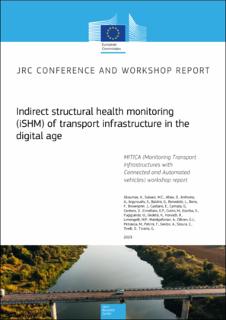| dc.contributor.author | Gkoumas, Konstantinos | |
| dc.contributor.author | Galassi, M.C. | |
| dc.contributor.author | Allaix, Diego | |
| dc.contributor.author | Anthonine, A | |
| dc.contributor.author | Argyroudis, S. | |
| dc.contributor.author | Baldini, G | |
| dc.contributor.author | Benedetti, Lorenzo | |
| dc.contributor.author | Bono, F | |
| dc.contributor.author | Brownjohn, James | |
| dc.contributor.author | Caetano, Elsa | |
| dc.contributor.author | Camata, G | |
| dc.contributor.author | Cantero, Daniel | |
| dc.contributor.author | Cimellaro, G.P. | |
| dc.contributor.author | Cutini, Maurizio | |
| dc.date.accessioned | 2023-03-09T12:30:13Z | |
| dc.date.available | 2023-03-09T12:30:13Z | |
| dc.date.created | 2023-01-27T11:27:19Z | |
| dc.date.issued | 2023 | |
| dc.identifier.uri | https://hdl.handle.net/11250/3057370 | |
| dc.description.abstract | The existing European motorway infrastructure network is prone to ageing and subject to natural events (e.g. climate change) and hazards (e.g. earthquakes), necessitating immediate actions for its maintenance and safety. Within this context, the structural health monitoring (SHM) framework allows a quantitative assessment of the structural integrity, serviceability and performance, facilitating better-informed decisions for the management of the existing infrastructure. The European Commission Joint Research Centre (JRC) established the exploratory research project MITICA (Monitoring Transport Infrastructures with Connected and Automated vehicles) to investigate the opportunity to use novel methods for infrastructure motoring, aiming at the efficient maintenance of the European aging road infrastructure. This report summarizes the discussion and the outcomes of a workshop held at the JRC in Ispra (Italy) on June 6-7 2022, as part of the MITICA project. Considering the EU priority “A Europe fit for the digital age”, the workshop was dedicated to SHM and its application to civil infrastructure, focusing on innovative indirect structural health monitoring (iSHM) approaches that rely on the vehicle-bridge interaction and the deployment of sensor-equipped vehicles for the monitoring of the existing bridge infrastructure. The report aims to become a reference document in the area of iSHM using passing vehicles, for both scholars and policy makers. | en_US |
| dc.language.iso | eng | en_US |
| dc.publisher | Publications Office of the European Union | en_US |
| dc.rights | Navngivelse 4.0 Internasjonal | * |
| dc.rights.uri | http://creativecommons.org/licenses/by/4.0/deed.no | * |
| dc.title | Indirect structural health monitoring (iSHM) of transport infrastructure in the digital age. MITICA (Monitoring Transport Infrastructures with Connected and Automated vehicles) workshop report. | en_US |
| dc.title.alternative | Indirect structural health monitoring (iSHM) of transport infrastructure in the digital age. MITICA (Monitoring Transport Infrastructures with Connected and Automated vehicles) workshop report. | en_US |
| dc.type | Research report | en_US |
| dc.description.version | publishedVersion | en_US |
| dc.source.pagenumber | 51 | en_US |
| dc.identifier.cristin | 2116364 | |
| cristin.ispublished | true | |
| cristin.fulltext | original | |

